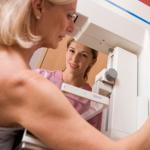A new study finds that women who have a mammogram every other year are less likely to get a suspicious result requiring additional testing as compared to women who have the breast cancer screening test every year.
The researchers found little risk in going two years between mammograms.
In 2009, a U.S. government expert committee, the U.S. Preventive Services Task Force, recommended breast cancer mammography every two years, starting at age 50. The previous standard was annual screening starting at age 40.
The change was controversial; many women and their doctors still follow the old recommendation.
This latest study examined the records of about 170,000 women who had mammograms. They found that a majority of women getting annual screenings had false-positive results.
"We found that more than half the women, after 10 years of annual screening, will be recalled for additional imaging," says Diana Miglioretti of the Group Health Research Institute in Seattle. "And it turns out they do not have cancer. And that seven percent of women will be recommended to have a biopsy that turns out not to show cancer."
Another finding in the study was that women who had mammograms every other year were slightly more likely to have a finding of cancer.
"We found a very small increase in the probability of having a late-stage breast cancer for women screened every two years, but this was not statistically significant," she says, meaning it may have been due to chance alone.
A suspicious mammogram which prompts further testing may be scary, but Miglioretti stresses that the vast majority of women who are called back for more imaging or even a biopsy do not have breast cancer.
She adds that one way to reduce the chance of a false-positive result is to have a baseline mammogram so the doctor can see any changes.
"One thing that we found that's important for women to know is that having comparison films available when the radiologist interprets your mammogram greatly reduced the probability of having a false-positive result."
Diana Miglioretti and her colleagues published their study in the Annals of Internal Medicine.
In a separate study in the same issue of that journal, researchers compared digital mammography with traditional film. Overall, the two produced comparable results, but for women in their 40s, digital screening may give better results.
However, the digital scans also produce more false positives, and an editorial in the journal by Philippe Autier, MD, of the International Prevention Research Institute in France suggests that widespread adoption of digital mammograms may reduce the efficiency of breast cancer screening.
